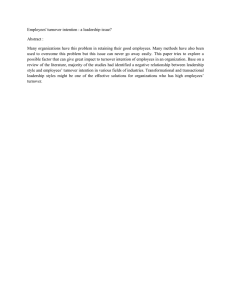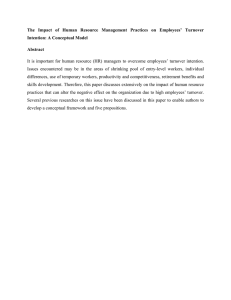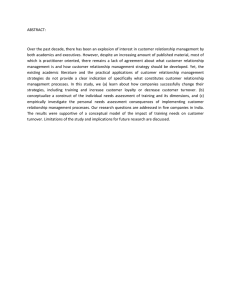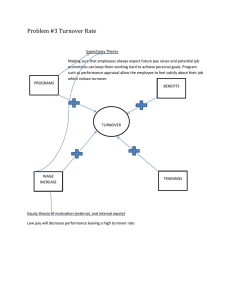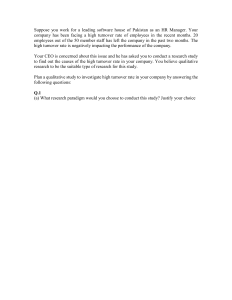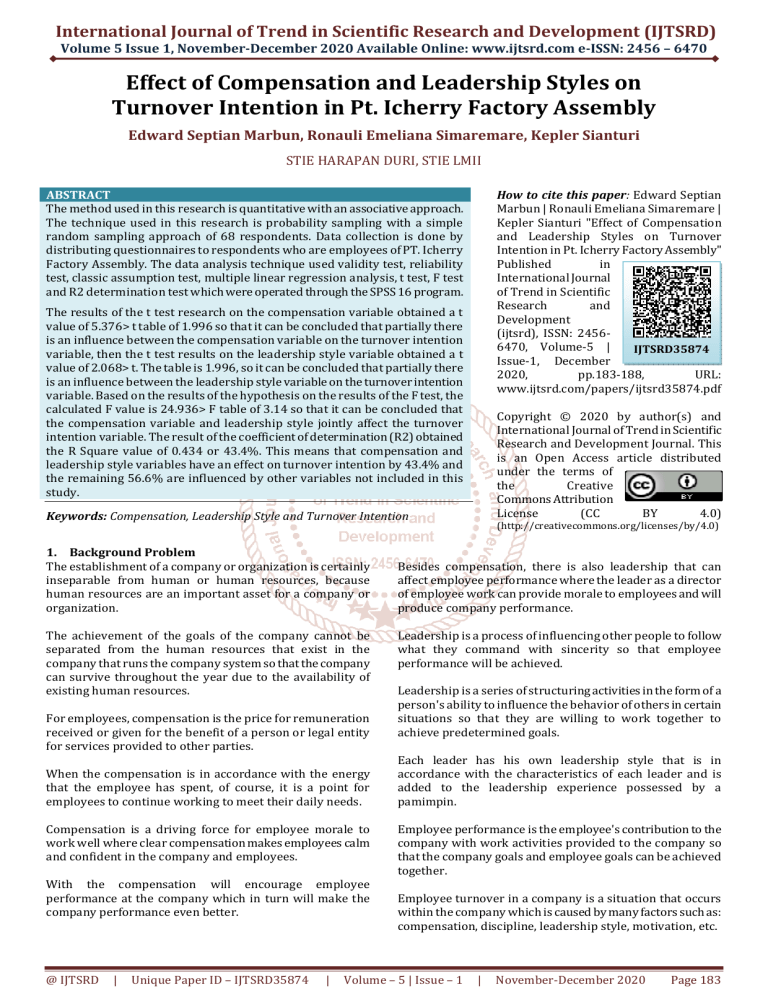
International Journal of Trend in Scientific Research and Development (IJTSRD)
Volume 5 Issue 1, November-December 2020 Available Online: www.ijtsrd.com e-ISSN: 2456 – 6470
Effect of Compensation and Leadership Styles on
Turnover Intention in Pt. Icherry Factory Assembly
Edward Septian Marbun, Ronauli Emeliana Simaremare, Kepler Sianturi
STIE HARAPAN DURI, STIE LMII
How to cite this paper: Edward Septian
Marbun | Ronauli Emeliana Simaremare |
Kepler Sianturi "Effect of Compensation
and Leadership Styles on Turnover
Intention in Pt. Icherry Factory Assembly"
Published
in
International Journal
of Trend in Scientific
Research
and
Development
(ijtsrd), ISSN: 24566470, Volume-5 |
IJTSRD35874
Issue-1, December
2020,
pp.183-188,
URL:
www.ijtsrd.com/papers/ijtsrd35874.pdf
ABSTRACT
The method used in this research is quantitative with an associative approach.
The technique used in this research is probability sampling with a simple
random sampling approach of 68 respondents. Data collection is done by
distributing questionnaires to respondents who are employees of PT. Icherry
Factory Assembly. The data analysis technique used validity test, reliability
test, classic assumption test, multiple linear regression analysis, t test, F test
and R2 determination test which were operated through the SPSS 16 program.
The results of the t test research on the compensation variable obtained a t
value of 5.376> t table of 1.996 so that it can be concluded that partially there
is an influence between the compensation variable on the turnover intention
variable, then the t test results on the leadership style variable obtained a t
value of 2.068> t. The table is 1.996, so it can be concluded that partially there
is an influence between the leadership style variable on the turnover intention
variable. Based on the results of the hypothesis on the results of the F test, the
calculated F value is 24.936> F table of 3.14 so that it can be concluded that
the compensation variable and leadership style jointly affect the turnover
intention variable. The result of the coefficient of determination (R2) obtained
the R Square value of 0.434 or 43.4%. This means that compensation and
leadership style variables have an effect on turnover intention by 43.4% and
the remaining 56.6% are influenced by other variables not included in this
study.
Copyright © 2020 by author(s) and
International Journal of Trend in Scientific
Research and Development Journal. This
is an Open Access article distributed
under the terms of
the
Creative
Commons Attribution
License
(CC
BY
4.0)
Keywords: Compensation, Leadership Style and Turnover Intention
1. Background Problem
The establishment of a company or organization is certainly
inseparable from human or human resources, because
human resources are an important asset for a company or
organization.
The achievement of the goals of the company cannot be
separated from the human resources that exist in the
company that runs the company system so that the company
can survive throughout the year due to the availability of
existing human resources.
For employees, compensation is the price for remuneration
received or given for the benefit of a person or legal entity
for services provided to other parties.
When the compensation is in accordance with the energy
that the employee has spent, of course, it is a point for
employees to continue working to meet their daily needs.
Compensation is a driving force for employee morale to
work well where clear compensation makes employees calm
and confident in the company and employees.
With the compensation will encourage employee
performance at the company which in turn will make the
company performance even better.
@ IJTSRD
|
Unique Paper ID – IJTSRD35874
|
(http://creativecommons.org/licenses/by/4.0)
Besides compensation, there is also leadership that can
affect employee performance where the leader as a director
of employee work can provide morale to employees and will
produce company performance.
Leadership is a process of influencing other people to follow
what they command with sincerity so that employee
performance will be achieved.
Leadership is a series of structuring activities in the form of a
person's ability to influence the behavior of others in certain
situations so that they are willing to work together to
achieve predetermined goals.
Each leader has his own leadership style that is in
accordance with the characteristics of each leader and is
added to the leadership experience possessed by a
pamimpin.
Employee performance is the employee's contribution to the
company with work activities provided to the company so
that the company goals and employee goals can be achieved
together.
Employee turnover in a company is a situation that occurs
within the company which is caused by many factors such as:
compensation, discipline, leadership style, motivation, etc.
Volume – 5 | Issue – 1
|
November-December 2020
Page 183
International Journal of Trend in Scientific Research and Development (IJTSRD) @ www.ijtsrd.com eISSN: 2456-6470
If a company experiences a high employee turnover rate, the
company is included in the unhealthy company category
because high employee turnover results in disruption of
company activities.
Both high employee turnover rates also result in the
discharge of skilled workers from within the company
because of the inconvenience of employees working at the
company.
2. Problem Formulation
Based on the background of the problem above, the problem
formulation is as follows:
A. How much influence does compensation have on
turnover intention to PT. Icherry Factory Assembly?
B. How much influence does leadership style have on
turnover intention at PT. Icherry Factory Assembly?
C. How much influence does compensation and leadership
style have on turnover intention at PT. Icherry Factory
Assembly?
3. Research Objectives
Based on the formulation of the problem above, it can be
formulated that the objectives of this study are as follows:
A. To find out how much influence compensation has had
on turnover intention at PT. Icherry Factory Assembly.
B. To find out how much influence the leadership style has
on turnover intention at PT. Icherry Factory Assembly.
C. To find out how much influence compensation and
leadership style have on turnover intention at PT.
Icherry Factory Assembly.
4. Research Benefits
From the objectives of this study, it is hoped that the results
of the research will benefit various parties, namely :
A. As a reference material for company leaders in taking
policies if there are problems, especially those related to
PT. Icherry Factory Assambly.
B. To add insight and compare the theory that the author
has studied in college with actual practice in the field,
particularly in relation to the effect of compensation and
leadership style on turnover intention at PT. Icherry
Factory Assambly.
C. The results of this study are also expected to be useful
for other parties as a reference and comparison material
for research on the effect of compensation and
leadership style on turnover intention.
5. Definition of Compensation
Compensation is a form of payment, wages or rewards given
to employees in return for what they have given or done to
the company. Compensation and remuneration are
important things in the company because this right is the
main goal for employees to be willing to work hard and work
enthusiastically.
Leadership is the most important factor in an organization
or company where when someone's leadership is good and
can make good relationships between employees and the
company because employees will do what their leaders have
ordered well.
Leadership is a process that affects group activities which
are organized to achieve common goals (Rauch & Behling in
Achmad Sanusi et al: 2014).
Leadership style is a way for leaders to influence their
subordinates to cooperate and work productively to achieve
predetermined organizational goals (Hasibuan, 2013).
Meanwhile, according to Rivai, 2014, states that leadership
style is a set of features used by leaders to influence
subordinates so that organizational goals are achieved or it
can also be said that leadership style is a pattern of behavior
and strategies that a leader likes and often applies when he
tries to influence the performance of his subordinates.
7. Definition of Employee Turnover
High employee turnover reflects that in the company there is
a bad company condition where there is a visible turnover of
employees in the company which results in disruption of
company activities.
Turnover is a condition of individual cessation of a member
of the organization concerned (Mobley: 2011).
Handoko, 2010, said that turnover is the entry and exit of
employees from one company to work for another company.
Malayu, 2012, also states that labor turnover is the ratio
between the entry and the stopping of employees from a
company.
Turnover is quite detrimental to the company because of the
many costs that have been incurred such as severance pay,
useless facilities to get replacement employees who leave,
staffing costs (such as recruitment costs, interviews, tests,
training costs and so on). The real disadvantage is the loss of
productivity until the new employee reaches the same level
of productivity as the former retiring employee.
8. Framework
From the research that has been done before, it can be
described a framework or scheme of the relationship
between compensation and leadership style on employee
turnover intention. Here's a picture of the frame of mind.
According to Veithzal Rivai, 2011, said that compensation is
something employees get in lieu of contributing their
services to the company.
Meanwhile, according to Ardana, 2012, compensation is
everything that an employee receives as remuneration for
his contribution to a company or organization.
6. Definition of Leadership Style
To understand the good leadership style, we must first
understand or know about leadership itself.
@ IJTSRD
|
Unique Paper ID – IJTSRD35874
|
9. Previous Research
A. Puni et al. (2016) examined the relationship between
leadership
style,
turnover
intentions,
and
counterproductive work behavior in eight branches of
Premier Gana Bank. Research by Puni et al. (2016),
Volume – 5 | Issue – 1
|
November-December 2020
Page 184
International Journal of Trend in Scientific Research and Development (IJTSRD) @ www.ijtsrd.com eISSN: 2456-6470
found a significant relationship between autocratic
leadership style, democracy, laissez-faire with tunover
intentions and counterproductive work behavior.
B. Liu et al. (2013), examined the effect of leadership style
on employee turnover intentions at Shenzhen and Hong
Kong companies. Liu et al. (2012), found that leadership
style has a significant effect on employee turnover
intentions. 5 Iskandar (2013),
C. Iskandar (2013), examined the influence of leadership
on turnover intentions of front office department
employees at the Ibis Bandung Trans Studio Hotel.
Iskandar's research (2013) found that there was a
significant influence between leadership and employee
turnover intention
D. Edward, Johannes, and Rofi'I, Muchid (2014) from the
Journal of Management Dynamics Vol.2 No.2 April-June
2014 ISSN: 2338–123X, 141-152 with the research title
"The Effect of Compensation and Organizational Climate
on Turnover Intention with Job Satisfaction as an
Intervening Variable at PT Trimitra Lestari ". The results
showed that: compensation has a positive and
insignificant effect on job satisfaction which will
increase the intention to move, organizational climate
has a positive but less significant effect on job
satisfaction which will increase the intention to move,
and job satisfaction has a negative and significant effect
that will increase the intention to move.
E. Putrianti, Arin Dewi (2014) from the Journal of Business
Administration (JAB) Vol. 12 No. July 2, 2014 p.1-9 with
the research title "The Effect of Compensation and Work
Motivation on Turnover Intention (Study on Employees
of PT TIKI, Nugraha Ekakurir, Pusat Malang)" The
results of this study show that there is a significant
effect of compensation and work motivation on turnover
intention.
F. Irbayuni, Sulastri (2012) from the Journal of NeO-Bis
Volume 6, No.1, June 2012, pp. 1-12, with the research
title "The Effect of Compensation, Job Satisfaction, and
Organizational Commitment on Desire to Move Work at
PT Surya Energy Resources Surabaya ”. The results
showed that compensation had no significant effect on
the desire to move employees, job satisfaction had a
positive and insignificant effect on the desire to move
employees, and organizational commitment had a
negative and significant effect on the desire to move
employees.
G. Research conducted by Bibowo, Adi and Masdupi, Erni
(2015) from the Journal of Business and Public
Management Research, Vol 3, No. 3, 2015, 1-16, with the
title "The Effect of Job Satisfaction, Compensation, and
Career Development on Turnover Intention to
employees of Bank Syariah Mandiri branch of Padang.
"The results of this study indicate that compensation
and career development positively and significantly
affect job satisfaction. Furthermore, compensation,
career development and job satisfaction all together
have a significant effect on turnover intention but only
individual job satisfaction has a significant and negative
effect on turnover intention.
10. Hypothesis
Hypotheses are temporary statements or conjectures in the
form of statements about a matter and their truth will be
tested. Hypotheses are also useful in providing clear
@ IJTSRD
|
Unique Paper ID – IJTSRD35874
|
objectives for researchers who will conduct research. The
provisional estimates in this study are as follows:
H1 : It is assumed that there is a partially significant
influence between the compensation variable (X1) on
turnover intention (Y).
H2 : It is assumed that there is a partially significant
influence between the leadership style variable (X2) on
turnover intention (Y).
H3 : It is assumed that there is a simultaneous significant
influence between the variable compensation (X1) and
leadership style (X2) on turnover intention (Y).
11. Research Methodology.
11.1. Research Form
The research method used in this research is a quantitative
method with an associative approach which aims to
determine the relationship between two or more variables
(Sugiono: 2012).
11.2. Location and Time of Research.
Location is a place or area to conduct research to obtain the
necessary data. This research was conducted at PT. Icherry
Factory Assembly, which is located at Jl. Paluh Wave, Tj.
Congratulations, Percut Sei Tuan, Deli Serdang Regency,
North Sumatra, 20371.
Time is a schedule for conducting research or the length of
the process of research activities carried out by the author.
The time of this research is during July - September 2019.
11.3. Population and Sample
Population
According to Sugiono, 2012, said that the population is a
generalization area consisting of objects / subjects that have
certain qualities and characteristics that are determined by
researchers to study and then draw conclusions. The
population in this study were all employees at PT. The
Icherry Factory Assembly consists of 216 people, namely
133 female employees and 83 male employees.
Sample
According to Sugiyono, 2010, said that the sample is part of
the number and characteristics possessed by the population.
The sample is the number of characteristics possessed by the
population. The sampling technique used in this research is
probability sampling with a simple random sampling
approach.
11.4. Data Collection Techniques
Data collection is a technique or methods used in collecting
research materials that can be used to answer the problems
at hand (Melva and Togu Harlen, 2011). The techniques used
in data collection in this study are:
A. Primary Data
Primary data is data obtained directly from the results of
direct empirical research from those directly involved using
certain data collection techniques (Sugiyono, 2010). Primary
data collection techniques used in this study are:
Data obtained directly from respondents using a
questionnaire distributed to employees of PT. Icherry
Factory Assemblies.
Data obtained from observations, namely data collection
through direct observation activities
Volume – 5 | Issue – 1
|
November-December 2020
Page 185
International Journal of Trend in Scientific Research and Development (IJTSRD) @ www.ijtsrd.com eISSN: 2456-6470
B. Secondary Data
Secondary data is data obtained from other parties or research from other parties (Sugiyono, 2010). Secondary data collection
techniques carried out in this study are:
Literature Study
Collecting data obtained from books, scientific works and opinions of experts who are competent and have relevance to the
phenomenon to be studied.
Documentation Studies
Collecting data using notes or written documentation, pictures, or other objects related to the phenomenon under study.
11.5. Hypothesis Results
11.5.1. Effect of Compensation (X1) on Turnover Intention (Y)
Based on the hypothesis test, it is known that partially compensation has an effect on turnover intention. The results of the t
test in this study can be seen in the table, which is as follows:
Coefficientsa
Model
1
(Constant)
Kompensasi
Gaya Kepemimpinan
Unstandardized
Standardized
Coefficients
Coefficients
t
B
Std. Error
Beta
5.429
3.277
1.657
.523
.097
.547
5.376
.136
.066
.210
2.068
Source: Processed Data (2019)
Sig.
Collinearity Statistics
.102
.000
.043
Tolerance
VIF
.842
.842
1.187
1.187
To find out whether the compensation variable affects turnover intention or not, the t test is used based on the criteria using a
significant level of 0.05 so that the t table value is as follows:
A. If the value of t count> t table, then H0 is rejected and H1 is accepted.
B. If the value of t count <t table, then H0 is accepted and H1 is rejected.
Based on the results of the SPSS 16 program output in the Coefficients table for the first regression coefficient, the service
quality variable shows the results of the t value of 5.376 > t table of 1.996 so that H1 is accepted and H0 is rejected. This means
that partially there is an effect of compensation on turnover intention.
11.5.2. The Effect of Leadership Style (X2) on Turnover Intention (Y)
Based on the hypothesis test, it is known that partially leadership style affects turnover intention. The results of the t test in this
study can be seen in the table, which is as follows:
Model
1
(Constant)
Kompensasi
Gaya Kepemimpinan
Coefficientsa
Unstandardized
Standardized
Coefficients
Coefficients
t
B
Std. Error
Beta
5.429
3.277
1.657
.523
.097
.547
5.376
.136
.066
.210
2.068
Source: Processed Data (2019)
Collinearity
Statistics
Tolerance
VIF
Sig.
.102
.000
.043
.842
.842
1.187
1.187
To find out whether the leadership style variable affects the turnover intention variable or not, the t test is used based on the
criteria using a significant level of 0.05 so that the t value is as follows:
A. If the value of t count> t table, then H0 is rejected and H1 is accepted.
B. If the value of t count <t table, then H0 is accepted and H1 is rejected.
Based on the results of the SPSS 16 program output in the Coefficients table for the first regression coefficient, the leadership
style variable shows the t value of 2.068> t table of 1.996 so that H1 is accepted and H0 is rejected. This means that partially
there is an influence of leadership style on turnover intention.
11.5.3. Effect of Compensation (X1) and Leadership Style (X2) on Turnover Intention (Y)
Based on the hypothesis test, it is known that the compensation variable and leadership style jointly affect the turnover
intention variable. The results of the F test in this study can be seen in the table, which are as follows:
ANOVAb
Model
Regression
1
Residual
Total
@ IJTSRD
|
Sum of Squares df Mean Square
541.716
2
270.858
706.049
65
10.862
1247.765
67
Source: Processed Data (2019)
Unique Paper ID – IJTSRD35874
|
Volume – 5 | Issue – 1
|
F
24.936
Sig.
.000a
November-December 2020
Page 186
International Journal of Trend in Scientific Research and Development (IJTSRD) @ www.ijtsrd.com eISSN: 2456-6470
To find out whether it is true that the first regression coefficient and the second regression coefficient on the compensation
independent variable and leadership style affect the dependent variable turnover intention. Calculating the F test using the
provisions of the significance level of 0.05 so that the F table value is 3.14 with the following criteria:
A. If F count> F table, then H0 is rejected and H1 is accepted.
B. If F count <F table, then H0 is accepted and H1 is rejected.
Based on the results of the SPSS 16 program output on the Anova table, it shows the calculated F value of 24.936> F table of
3.14 so that H0 is rejected and H1 is accepted. This means that the independent variable compensation and leadership style
jointly affect the dependent variable turnover intention.
11.5.4. Coefficient of Determination R2
The results of the coefficient of determination test can be seen in the table, which is as follows :
Model
R
1
.659a
R
Square
.434
Adjusted
R Square
.417
Model Summaryb
Std. Error of
the Estimate R Square Change
3.296
.434
Source: Processed Data (2019)
Change Statistics
F Change df1 df2
24.936
2
65
Sig. F Change
.000
To find out how much influence the first regression coefficient and the second regression coefficient on the independent
variable compensation and leadership style jointly affect the dependent variable turnover intention using the help of the SPSS
16 program.
Based on the results of the SPSS 16 program output in the Model Summary table, the R Square value is 0.434 or 43.4%. This
means that the independent variable compensation and leadership style affect the dependent variable turnover intention by
43.4% and the rest is influenced by other factors not examined in this study, such as age, location, environment, job satisfaction,
workload, length of work and others.
12. Conclusion and Suggestion.
12.1. Conclusion
Based on this research which aims to determine "The Effect
of Compensation and Leadership Style on Turnover
Intention at PT. Icherry Factory Assambly”. Based on
research and the results of the data that have been processed
in this study, the following conclusions are obtained:
A. Based on the results of the hypothesis on the results of
the t test on the compensation variable, the t value of
5.376> t table is 1.996 so it can be concluded that
partially there is an influence between the
compensation variable on the turnover intention
variable.
B. Based on the results of the hypothesis on the results of
the t test on the leadership style variable, the t value is
2.068 <t table of 1.996 so it can be concluded that
partially there is an influence between the leadership
style variable on the turnover intention variable.
C. Based on the results of the hypothesis on the results of
the F test, the calculated F value is 24.936 > F table of
3.14 so it can be concluded that the compensation
variable and leadership style jointly affect the turnover
intention variable.
D. Based on the results of the determination coefficient
(R2), the R Square value is 0.434. This means that
compensation and leadership style variables affect
turnover intention by 43.4% and the remaining 56.6%
are influenced by other variables not included in this
study, for example age, location, environment, job
satisfaction, workload, length of time. work and others.
A. PT. Icherry Factory Assambly
PT. Icherry Factory Assambly needs to adjust the
compensation given to employees with what employees
have sacrificed for the company, so that employees feel
satisfied with the reply they receive from the company.
Compensation should also be given in accordance with
the promised schedule and presumably the company
will provide compensation in a transparent manner.
Compensation that is in accordance with predetermined
provisions will certainly be one of the reasons for
employees to stay or not stay in their job, because they
need it in meeting their daily needs.
PT. Icherry Factory Assambly needs to pay attention to
and improve their leadership style in a direction that
makes employees more comfortable in doing their job.
Hopefully the leaders can establish a good cooperative
relationship between employees and their leaders in
order to achieve the goals of the company. Because
employees and leaders each have different attitudes in
responding to a problem or situation, some are easily
offended or easy to understand, some are capable but
must be explained in detail and so on. Leaders should
pay attention to their leadership style and they should
lead not to put too much pressure on their subordinates.
12.2. Suggestion
After conducting research, discussion, and drawing
conclusions from the results of the study, the authors
provide suggestions regarding the research that has been
carried out to be used as input and useful consideration for
interested parties, namely as follows:
REFERENCES
[1] Arikunto, S. (2010). Prosedur Penelitian: Suatu
Pendekatan Praktik. Jakarta: Rineka Cipta.
[2] Kaswan. 2012. Manajemen Sumber Daya Manusia
untuk Keunggulan Bersaing Organisasi. Yogyakarta
Graha Ilmu. hlm: 146.
@ IJTSRD
|
Unique Paper ID – IJTSRD35874
|
B. For Further Researchers
The next researcher is expected to be able to analyze other
variables which are factors in the emergence of purchasing
decisions such as price, location, social class, culture, future
and so on.
Volume – 5 | Issue – 1
|
November-December 2020
Page 187
International Journal of Trend in Scientific Research and Development (IJTSRD) @ www.ijtsrd.com eISSN: 2456-6470
[3]
Hasibuan, Malayu. 2010. Manajemen Sumber Daya
Manusia, edisi revisi. Jakarta: PT. Bumi Aksara.
[4]
Lumban Raja, Togu Harlen, Sitanggang HD. Melva
2015. MetodologiPenelitian. Cetakan Kedua. Medan:
CV. Indah Karunia Jaya.
[5]
Mobley, William H. 2011. Pergantian karyawan: Sebab
Akibat dan Pengendaliannya. Jakarta: PPM dan Bisnis
2030.
[6]
Rivai dan Ella.2010. Manajemen Sumber Daya
Manusia. Jakarta: PT Raja Grafindo Persada. hlm: 744749.
[7]
Rivai, Veithzal.2011.Menejemen Sumber Daya Manusia
untuk Perusahaan dari Teori Ke Praktik, Jakarta: Raja
Grafindo.
[8]
Rivai, Veithzal, dkk. 2018.Menejemen Sumber Daya
Manusia untuk Perusahaan dari Teori Ke Praktik, edisi
3 cetakan ke 6 Jakarta: Rajawali Pers.
[9]
Sagala Syaiful. (2018). Pendekatan dan Model
Kepemimpinan. Edisi Pertama. Jakarta: Prenadamedia
Group.
karyawan terhadap Turnover intention
karyawan Auto 2000 Malang-Sutoyo.
[4]
Hidayati, Siti Nur dan Saputra, Suryadi Dwi. 2018.
Jurnal Maksipreneur, Vol 7, No 2 Juni 2018, hal 162173, dengan judul “ Pengaruh Kepemimpinan,
Kompensasi, komunikasi dan Motivasi kerja terhadap
Turnover Intention pegawai dengan Kepuasan kerja
sebagai variabel antara.
[5]
Irbayuni,Sulastri (2012). Pengaruh Kompensasi,
Kepuasan Kerja, Komitmen organisasi terhadap
keinginan untuk pindah kerja pada PT. Surya Sumber
Daya Energi Surabaya. Jurnal Neo-Bis Volume 6, No 1,
2012.
[6]
Iskandar Syarief, Marhanah Sri dan Kusumah, A. H.
Galih. 2015. Jurnal Manajemen Resort dan Leisure, vol
12, No 2 Oktober 2015, dengan judul “ Pengaruh
Kepemimpinan Terhadap Turnover Intention
karyawan Departement Front Office di Hotel IBIS
Bandung Trans Studio.
[7]
Johannes, Edward, dan Rofi’I, (2014). Pengaruh
Kompensasi dan Iklim Organisasi terhadap Turnover
Intension dengan Kepuasan Kerja Sebagai Variable
Intervening. Jurnal Dinamika Manajemen Vol. 2 No. 2
April– Juni 2014 ISSN: 2338–123 X.
[8]
Mondiani, Tria. 2014, Pengaruh kepemimpinan
transformasional dan Kompensasi Terhadap Kinerja
KaryawanPT. PLN (Persero) UPJ Semarang, Juarnal
Administrasi Bisnis, Vol 1, No 1.
[9]
Paripurna, I Gede diatmika, Supartha, I Wayan Gede
dan Subudi Made. 2017. Jurnal ekonomi dan bisnis
Universitas Udayana, vol 6, no 6 (2017), ISSN: 23373067, judul jurnal “ Pengaruh Kepemimpinan dan
Kepuasan kerja terhadap Turnover serta dampaknya
terhadap kinerja karyawan pada PT. Agung Automall
Kuta.
[10]
Shobirin Muhamad, Miniarsih Maria dan Fathoni Aziz.
2016. Journal of Management, Vol 02, No 02 Maret
2016, dengan judul “ Analisis Pengaruh Gaya
Kepemimpinan, Komitmen Organisasi dan Kepuasan
Kerja terhadap Keinginan Pindah Kerja Karyawan PT.
Bank BTPN Mitra Usaha Rakyar Area Semarang.
[11]
Zakaria Royan dan Astuty Isthofaina. 2017. Jurnal
Manajement
fakultas
Ekonomi
universitas
Muhammadiyah Yogyakarta, Vol 8, No 1 Maret 2017,
dengan Judil “ Pengaruh Kompensasi terhadap
Turnover Intention pada Job Embeddedness sebagai
variabel Intervening pada karyawan PT. Primissima.
[12]
Zaki Hammam dan Marzolina. 2016. Jurnal Tepak
Manajemen Bisnis1, Vol VIII, No 3 Sep 2016, dengan
judul “Pengaruh Beban Kerja dan Kompensasi
terhadap Turnover Intention Melalui Kepuasan Kerja
pada Karyawan PT. Adira Quantum Multifinance.s
[10] Samsudin Sadili.2010. Manajemen Sumber Daya
Manusia. Cetakan ke 3. Bandung:CV Pustaka Setia
[11] Setiawan, Budi 2013. Menganalisa Statistik Bisnis dan
Ekonomi dengan SPSS 21. Edisi I. Yogyakarta: ANDI.
[12] Sugiyono. (2010). Metode Penelitian Admisistrasi.
Bandung: CV Alfabeta.
[13] Sugiono. (2012). Metode Penelitian Bisnis. Cetakan ke
16. Bandung: Alvabeta, CV.
[14] Sugiyono 2018. Metode Penelitian Kuantitatif,
Kualitatif dan R&D. Cetakan Ke-20. Bandung: Alfabeta.
[15] Sunyonto, Danang 2013. Teori, Kuesioner, dan Analisis
Data. Cetakan Pertama. Yogyakarta: Graha Ilmu.
JURNAL
[1] Bibowo, Adi dan Masdupi, Erni (2015) dari Jurnal
Riset Manajemen Bisnis dan Publik, Vol 3, No 3, 2015 ,
1-16, dengan judul “Pengaruh Kepuasan Kerja,
Kompensasi, dan Pengembangan Karir terhadap
Turnover Intention pada Karyawan Bank Syariah
Mandiri cabang Padang”.
[2]
[3]
Dewi, Nikadek Novalia Citra dan subudi Made. 2015.
Jurnal Manajemen Unud, vol 4, No 12, 2015, ISSN:
2302-8912. Judul jurnal “Pengaruh Kepemimpinan
Transformasional terhadap Kepuasan kerja dan
Turnover Intention pada CV. Gita karya Persada
Denpasar.
Fuaidah Nurriqoh, Sunurhayo, Bambang Swasto dan
Aini, Edlyn Khurotul. 2018. Jurnal Administrasi Bisnis
(JAB), Vol 60, No 2 Juli 2018, dengan judul “ Pengaruh
Kompensasi karyawan dan lingkungan kerja
@ IJTSRD
|
Unique Paper ID – IJTSRD35874
|
pada
Volume – 5 | Issue – 1
|
November-December 2020
Page 188

